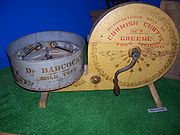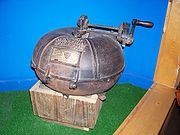
Babcock test
Encyclopedia


Fat content of milk
The fat content of milk is the proportion of milk, by weight,made up by butterfat. The fat content, particularly of cow's milk, is modified to make a variety of products...
.
Motivation
Until the 1890s, dishonest farmers could water down their milkMilk
Milk is a white liquid produced by the mammary glands of mammals. It is the primary source of nutrition for young mammals before they are able to digest other types of food. Early-lactation milk contains colostrum, which carries the mother's antibodies to the baby and can reduce the risk of many...
or remove some cream
Cream
Cream is a dairy product that is composed of the higher-butterfat layer skimmed from the top of milk before homogenization. In un-homogenized milk, over time, the lighter fat rises to the top. In the industrial production of cream this process is accelerated by using centrifuges called "separators"...
before selling it to the factories because milk was paid for by volume. Honest farmers, as well as those that produced naturally rich milk, were not being compensated fairly.
Babcock Test process
Stephen Moulton BabcockStephen Moulton Babcock
Stephen Moulton Babcock was a U.S. agricultural chemist. He is best known for his Babcock test in determining dairy butterfat in milk processing, in cheese processing, and in the "single-grain experiment" that would lead to the development of nutrition as a science.-Early life and career:Born on a...
researched the problem at the University of Wisconsin–Madison
University of Wisconsin–Madison
The University of Wisconsin–Madison is a public research university located in Madison, Wisconsin, United States. Founded in 1848, UW–Madison is the flagship campus of the University of Wisconsin System. It became a land-grant institution in 1866...
and developed the following process:
- Measure milk into graduated test tube. You usually take 18 grams of milk or 17.6 milliliters.
- Add 17.6 milliliters of 90-92% sulfuric acid.
- Centrifuge at 50°C.
- Measure fat which will be floating on top of liquid in the test tube.
Principle of Babcock test
Key to this process is that everything in milk except the fatFat
Fats consist of a wide group of compounds that are generally soluble in organic solvents and generally insoluble in water. Chemically, fats are triglycerides, triesters of glycerol and any of several fatty acids. Fats may be either solid or liquid at room temperature, depending on their structure...
dissolves in sulfuric acid
Sulfuric acid
Sulfuric acid is a strong mineral acid with the molecular formula . Its historical name is oil of vitriol. Pure sulfuric acid is a highly corrosive, colorless, viscous liquid. The salts of sulfuric acid are called sulfates...
.
The fat floats to the top. The centrifuge ensures complete separation with no bubbles in the fat, and the fat content can be measured using the graduations on the test tube
Test tube
A test tube, also known as a culture tube or sample tube, is a common piece of laboratory glassware consisting of a finger-like length of glass or clear plastic tubing, open at the top, usually with a rounded U-shaped bottom....
and knowing the initial amount of milk used.
Utility of Babcock test
After the development of the test, it was much easier for a dairy operation to not only compensate farmers fairly, but to produce a consistent product that consumers could depend on. The Babcock test was also utilized by farmers to selectively breed for cows who produced milk with higher butterfat content—the tests were usually done monthly by an employee of the local Dairy Herd Improvement Association (DHIA).In 1911, the American Dairy Science Association
American Dairy Science Association
The American Dairy Science Association is a non-profit professional organization for the advancement of dairy science. ADSA is headquartered in Savoy, Illinois, located near the Urbana-Champaign, Illinois area....
's Committee on Official Methods of Testing Milk and Cream for Butterfat, chaired by O. F. Hunziker
Otto Frederick Hunziker
Otto Frederick Hunziker was a pioneer in the American and international dairy industry, as both an educator and a technical innovator. Otto Hunziker was born and raised in Switzerland, emigrated to the U.S., and studied at Cornell University. He started and developed the dairy program at Purdue...
, met in Washington DC with the U.S. Bureau of Dairying, the U.S. Bureau of Standards and manufacturers of glassware. Standard specifications for Babcock glassware were published as a result of this meeting.
About Babcock
Professor Babcock did not patent his invention considering himself an agent of WisconsinWisconsin
Wisconsin is a U.S. state located in the north-central United States and is part of the Midwest. It is bordered by Minnesota to the west, Iowa to the southwest, Illinois to the south, Lake Michigan to the east, Michigan to the northeast, and Lake Superior to the north. Wisconsin's capital is...
working for the welfare of Wisconsin.
See also
- Stephen Moulton BabcockStephen Moulton BabcockStephen Moulton Babcock was a U.S. agricultural chemist. He is best known for his Babcock test in determining dairy butterfat in milk processing, in cheese processing, and in the "single-grain experiment" that would lead to the development of nutrition as a science.-Early life and career:Born on a...
- HydrometerHydrometerA hydrometer is an instrument used to measure the specific gravity of liquids; that is, the ratio of the density of the liquid to the density of water....
- Device for measuring milk's relative density - Fat content of milkFat content of milkThe fat content of milk is the proportion of milk, by weight,made up by butterfat. The fat content, particularly of cow's milk, is modified to make a variety of products...
- Niklaus GerberNiklaus GerberNiklaus Gerber was a Swiss dairy chemist and industrialist. He was born in 1850 in Thun, Switzerland. He attended the University of Bern and University of Zurich, studied chemistry in Paris and Munich and spent 2 years at the Swiss-American Milk Co. in Little Falls, New York.In 1887, Gerber...
- Gerber MethodGerber methodThe Gerber Method is a primary and historic chemical test to determine the fat content of milk and other substances. The Gerber Method is the primary testing method in Europe and much of the world. The fairly similar Babcock test is used primarily in the United States, although the Gerber Method...

